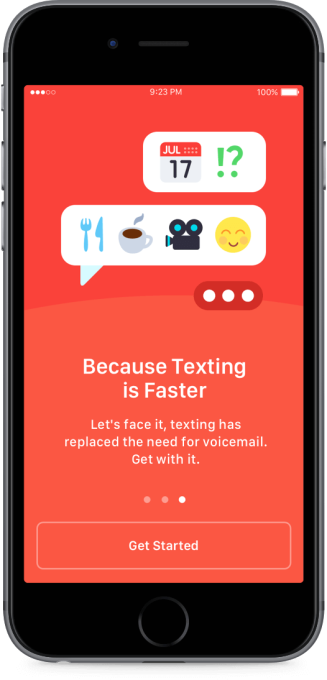Voicemail is so last century. The idea of phoning someone then leaving a rambling message when they don’t pick up seems decidedly antiquated in the age of instant connectivity, where friends, family, colleagues and others can be easily reached with a text. Voicemail is so over, in fact, that large corporations like JP Morgan and Coca-Cola have ditched the service entirely. If only consumers had the same option.
Well, thanks to a new app simply called No More Voicemail, they now do. Available for both iOS and Android devices, No More Voicemail is a clever solution to the voicemail problem.
Today, if you want to actually deactivate voicemail, you would have to contact your carrier and explain that you don’t want the service. That’s a hassle in and of itself. And if you ever want to turn voicemail back on for any reason, you’d have to call the carrier again to re-enable it.

No More Voicemail offers a different solution. The app isn’t actually disabling voicemail per the carrier – it only seems like it is. Instead, No More Voicemail uses the conditional call forwarding feature on your phone to send your unanswered calls to a virtual number that will just ring and ring.
This is the same concept that’s used today in other legit third-party voicemail apps like YouMail or Google Voice, expect it ditches the idea of offering a hosted voicemail system.
Calls won’t be shuffled off to No More Voicemail’s third-party system until you reject or ignore the call. That means you’re able to pick up calls normally when you have time to talk.
But if you choose to not take a call, the callers will just hear the phone ring forever, the company claims.
Eventually, callers should get tired of waiting for voicemail to pick up and will hang up. (Then hopefully text you instead!)
The process of setting up No More Voicemail is straightforward. You’re provided an activation code to copy and paste into your phone’s dialer, which you then call to make the necessary changes.
[gallery ids="1285666,1285667,1285668,1285669,1285670,1285671"]
In practice, I found that this process failed the first time I tried it, then succeeded on the second go-round. When testing this further, I declined an incoming call, but found that the phone didn’t ring indefinitely as promised, but rather rang a bit then automatically disconnected the call.
Sadly, that’s far from perfect. But even if it’s a little buggy, it did prevent my voicemail from picking up and taking the call on my behalf. And I’m hopeful these kinks will get worked out over time.
(I’m using an iPhone 6s running a beta build of iOS on T-Mobile, so it’s possible that I’m not the best test subject, I should point out. Your mileage may vary!)
Disabling No More Voicemail uses a similar process as activating the service. This worked as advertised in tests.
The app is the latest creation from TelTech Systems, a company that has released a number of telecommunications apps over the years. It’s probably best known for TrapCall, a service released in 2009 that unmasked Caller ID on blocked incoming calls, or its earlier SpoofCard Caller ID spoofing service.
“We think voicemail is a thing of the past and that it just makes life a little easier to never have to worry about checking and returning voicemails,” explains TelTech partner on Special Projects, Nate Kapitanski. “If it’s important, people will text you or message you on one of the various messaging apps,” he says.
No More Voicemail is supported on all the major carriers at launch, including AT&T, Verizon, T-Mobile, Sprint and US Cellular. The app is a free download on the iTunes App Store and Google Play.
